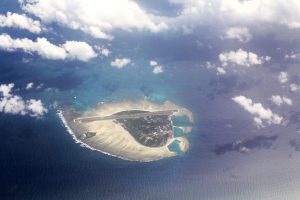Vietnam has joined three other Southeast Asian governments in denouncing a new map published by China’s government, which depicted the country’s expansive claims in the South China Sea.
The so-called “new standard” map, which was published by China’s Ministry of Natural Resources on August 28, has prompted inflamed responses from across the country’s periphery, where China has a number of outstanding maritime and territorial disputes.
In particular, the map’s depiction of the South China Sea has included the expansive “nine-dash line” claim, with a tenth dash added to the east of the island of Taiwan. According to Reuters, the new standard map contains a wider version of the Chinese claim than the map that China submitted to the United Nations in 2009.
Late yesterday, Pham Thu Hang, the spokesperson for Vietnam’s Ministry of Foreign Affairs, said in a statement that the sovereignty and maritime claims outlined on the map, in particular, the inclusion of the Paracel and Spratly island chains, were “invalid.” She said that they had “violated Vietnam’s sovereignty over the islands, as well as its sovereignty, sovereignty rights, and jurisdiction rights over Vietnam’s sea regions as determined by the United Nations Convention on the Law of the Sea (UNCLOS).”
Vietnam, Pham added, “resolutely rejects any claims in the East Sea by China that are based on the dashed line.”
The Vietnamese response followed reports from Vietnamese fishermen that a Chinese vessel attacked their fishing boat with a high-pressure water cannon in the South China Sea on August 28, injuring two of them. This is consistent with an increase in Chinese incursions into waters also claimed by Vietnam.
Vietnam has become the fourth member state of the Association of Southeast Asian Nations (ASEAN) to publicly respond to Beijing’s map, which has also prompted outrage from the government of India, for its inclusion of the state of Arunachal Pradesh as part of China.
The first Southeast Asian nation to register its concern about the map was Malaysia, which wrote in a statement on Wednesday that China’s “unilateral maritime claims” included additional waters claimed by Kuala Lumpur close to the states of Sabah and Sarawak.
“Malaysia does not recognize China’s claims in the South China Sea as outlined in the ‘2023 edition of the standard map of China’ which extends into Malaysian maritime area,” the foreign ministry said. “The map has no binding effect on Malaysia.” The government said that it had filed a formal diplomatic protest over the map.
The Philippines followed suit yesterday, calling on China “to act responsibly and abide by its obligations” under international law and a 2016 arbitral ruling, filed by the Philippines in 2013, that had declared the “nine-dash line” had no standing under international law. Indonesia’s Foreign Minister Retno Marsudi has also weighed in on the map, claiming that “any line drawn, any claims made must be in accordance with the 1982 UNCLOS.”
As with Vietnam, the Philippines has also faced growing Chinese pressure in disputed waters, including an incident last month in which a Chinese coast guard vessel fired a high-pressure water cannon at Philippine vessels seeking to resupply Phiilippine personnel stationed on Second Thomas Shoal in the Spratly Islands.
As one would expect, China’s government has brushed off the concerns of its neighbors.
“China’s position on the South China Sea issue has always been clear. The competent authorities of China regularly update and release various types of standard maps every year,” Chinese Foreign Ministry spokesperson Wang Wenbin told a regular press briefing in Beijing. “We hope that relevant parties can view this in an objective and rational manner.”
The coordinated pushback against the Chinese claims is a good sign for a region that has often been accused of a lack of unity in the face of China’s maximalist (and unlawful) maritime claims. The thing to watch now is whether this will result in anything concrete at next week’s ASEAN summit meetings in Jakarta.

































